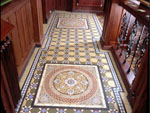Dream house: Decorative tiler
Susannah Glynn talks to a decorative tiler who specialises in making and restoring Victorian tiles...


Just as the uses for tiles are varied and imaginative, so too are the skills and techniques employed in their decoration. Mark Harris is a production manager at Craven Dunnill Jackfield in Shropshire, a company formed in 1872 that specialises in making and restoring Victorian tiles. Inlaid floor tiles were common in Britain from medieval times, but it was during the 19th century that advances in technology and improved social and economic conditions led to the wider use of decorative tiles, on the walls of domestic buildings, hospitals and stations, as well as on furniture. They even became artworks themselves. At Craven Dunnill, most tiles are produced by dust pressing, a technique pioneered in the 1840s, whereby fine, white clay dust any impurities will muddy the glaze is mixed with a little water and placed into a stainless steel 'die'. There, it is subjected to 10 to 15 tons of pressure. 'We use only the old Victorian fly-wheel presses here,' says Mr Harris. 'The tonnage of pressure is what drives out the moisture and bonds the dust together.' Moulded tiles are 'slip cast' a mixture of clay and malachite is poured into a plaster mould which then literally sucks the moisture out of the mix, leaving behind a solid form which is hardened by firing. 'It is quite a time consuming and expensive process, because one mould only produces about 10 pieces. The recent restoration at Leeds Library required about 1,200 pieces.' Tiles are glazed after the first, or 'biscuit' firing. 'We use the same oxides the Victorians would have used to get the required colours: copper oxide for greens and cobalt oxides for blues, red iron for brown and so on. We do sometimes struggle with certain colours, such as bright red, because you aren't allowed to use substances such as cadmium in large quantities any more.' The majority of tiles are dipped by hand into the glazes, timed with a metronome to ensure the 'graiing' (weight of colour) is consistent between tiles. Methods for more complex decoration include 'tube-lining' 'which is a little like icing a cake' and silk screen printing. Tube lining recreates the striking and individual pieces that reached their heyday in Art Nouveau schemes, and are increasingly popular today. Areas of colour are separated by raised lines of slip (some-times tinted) piped onto the surface of the biscuit. Silk-screen printing involves literally pushing each colour through a fine mesh silk screen onto the tile using a rubber squeegee, exactly the same technique that is used to print fabric. Applied directly onto the biscuit, it is known as underglaze printing; onto a glazed tile, it is on glaze. 'I worked for a silk-screen printing company and got made redundant,' says Mr Harris. 'Then I got a job at a tile factory at Jackfield. Everything about ceramics has been learnt as I've gone along. 'We restored the Stranger's Servery at The House of Commons a few years ago. In the 1980s, they had put a wood cladding over the walls, and when it was ripped off, they discovered these very over-the-top, original Pugin tiles beneath, many of which had been damaged. What was also wonderful about that project was seeing it all in situ normally, we make it all here and never see the finished work in place.' Susannah Glynn Craven Dunnill Jackfield 01952 884124. Top tips Never clean tiles with ordinary tap water as this can cause salt growths; use distilled water with a little gentle non-ionic detergent. Scrapers such as wire wool will permanently damage the glaze em> Tiles should be stored on edge. The lowest ones may shatter if kept in a pile em> Small quantities of restricted pigments can be used to recreate original glazes em>
Exquisite houses, the beauty of Nature, and how to get the most from your life, straight to your inbox.
Country Life is unlike any other magazine: the only glossy weekly on the newsstand and the only magazine that has been guest-edited by His Majesty The King not once, but twice. It is a celebration of modern rural life and all its diverse joys and pleasures — that was first published in Queen Victoria's Diamond Jubilee year. Our eclectic mixture of witty and informative content — from the most up-to-date property news and commentary and a coveted glimpse inside some of the UK's best houses and gardens, to gardening, the arts and interior design, written by experts in their field — still cannot be found in print or online, anywhere else.

